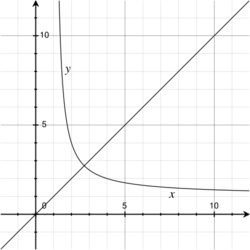Equation xʸ=yˣ
In general, exponentiation fails to be commutative. However, the equation [math]\displaystyle{ x^y=y^x }[/math] holds in special cases, such as [math]\displaystyle{ x=2,\ \ y=4. }[/math][1]
History
The equation [math]\displaystyle{ x^y=y^x }[/math] is mentioned in a letter of Bernoulli to Goldbach (29 June 1728[2]). The letter contains a statement that when [math]\displaystyle{ x\ne y, }[/math] the only solutions in natural numbers are [math]\displaystyle{ (2,4) }[/math] and [math]\displaystyle{ (4,2), }[/math] although there are infinitely many solutions in rational numbers.[3][4] The reply by Goldbach (31 January 1729[2]) contains general solution of the equation obtained by substituting [math]\displaystyle{ y=vx. }[/math][3] A similar solution was found by Euler.[4]
J. van Hengel pointed out that if [math]\displaystyle{ r, n }[/math] are positive integers with [math]\displaystyle{ r\geq 3 }[/math] then [math]\displaystyle{ r^{r+n} \gt (r+n)^{r}; }[/math] therefore it is enough to consider possibilities [math]\displaystyle{ x = 1 }[/math] and [math]\displaystyle{ x = 2 }[/math] in order to find solutions in natural numbers.[4][5]
The problem was discussed in a number of publications.[2][3][4] In 1960, the equation was among the questions on the William Lowell Putnam Competition[6][7] which prompted Alvin Hausner to extend results to algebraic number fields.[3][8]
Positive real solutions
- Main source:[1]
An infinite set of trivial solutions in positive real numbers is given by [math]\displaystyle{ x=y. }[/math]
Nontrivial solutions can be found by assuming [math]\displaystyle{ x\ne y }[/math] and letting [math]\displaystyle{ y = vx. }[/math] Then
- [math]\displaystyle{ (vx)^x = x^{vx} = (x^v)^x. }[/math]
Raising both sides to the power [math]\displaystyle{ \tfrac{1}{x} }[/math] and dividing by [math]\displaystyle{ x, }[/math]
- [math]\displaystyle{ v = x^{v-1}. }[/math]
Then nontrivial solutions in positive real numbers are expressed as
- [math]\displaystyle{ x = v^{\frac{1}{v-1}}, }[/math]
- [math]\displaystyle{ y = v^{\frac{v}{v-1}}. }[/math]
Setting [math]\displaystyle{ v=2 }[/math] or [math]\displaystyle{ v=\tfrac{1}{2} }[/math] generates the nontrivial solution in positive integers, [math]\displaystyle{ 4^2=2^4. }[/math]
Other pairs consisting of algebraic numbers exist, such as [math]\displaystyle{ \sqrt3 }[/math] and [math]\displaystyle{ 3\sqrt3 }[/math], as well as [math]\displaystyle{ \sqrt[3]4 }[/math] and [math]\displaystyle{ 4\sqrt[3]4 }[/math].
The trivial and non-trivial solutions intersect when [math]\displaystyle{ v = 1 }[/math]. The equations above cannot be evaluated directly, but we can take the limit as [math]\displaystyle{ v\to 1 }[/math]. This is most conveniently done by substituting [math]\displaystyle{ v = 1 + 1/n }[/math] and letting [math]\displaystyle{ n\to\infty }[/math], so
- [math]\displaystyle{ x = \lim_{v\to 1}v^{\frac 1{v-1}} = \lim_{n\to\infty}\left(1+\frac 1n\right)^n = e. }[/math]
Thus, the line [math]\displaystyle{ y=x }[/math] and the curve for [math]\displaystyle{ x^y-y^x=0,\,\, y \ne x }[/math] intersect at x = y = e.
Similar graphs
The equation [math]\displaystyle{ \sqrt[x]y=\sqrt[y]x }[/math] produces a graph where the line and curve intersect at [math]\displaystyle{ 1/e }[/math]. The curve also terminates at (0,1) and (1,0), instead of continuing on for infinity.
The equation [math]\displaystyle{ log_x(y)=log_y(x) }[/math] produces a graph where the curve and line intersect at (1,1). The curve (which is actually the positive section of y=1/x) becomes asymptotic to 0, as opposed to 1.
References
- ↑ 1.0 1.1 Lóczi, Lajos. "On commutative and associative powers". KöMaL. Archived from the original on 2002-10-15. https://web.archive.org/web/20021015103129/http://www.komal.hu/cikkek/loczy/powers/commpower.e.shtml. Translation of: "Mikor kommutatív, illetve asszociatív a hatványozás?" (in hu). Archived from the original on 2016-05-06. https://web.archive.org/web/20160506183127/http://db.komal.hu/KomalHU/cikk.phtml?id=200047.
- ↑ 2.0 2.1 2.2 Singmaster, David. "Sources in recreational mathematics: an annotated bibliography. 8th preliminary edition". Archived from the original on April 16, 2004. https://web.archive.org/web/20040416081838/http://www.gotham-corp.com/sources.htm#_Toc69534169.
- ↑ 3.0 3.1 3.2 3.3 "On the Rational Solutions of xy = yx". Mathematics Magazine. 1990. Archived from the original on 2016-03-04. https://web.archive.org/web/20160304191325/http://www.maa.org/sites/default/files/Sved50816668.pdf.
- ↑ 4.0 4.1 4.2 4.3 "Rational solutions of xy = yx", History of the Theory of Numbers, II, Washington, 1920, pp. 687, https://books.google.com/books?id=dO7C02z4LlcC&pg=PA687
- ↑ van Hengel, Johann (1888). Beweis des Satzes, dass unter allen reellen positiven ganzen Zahlen nur das Zahlenpaar 4 und 2 für a und b der Gleichung ab = ba genügt. http://digital.ub.uni-duesseldorf.de/ulbdsp/periodical/titleinfo/4315444.
- ↑ "The twenty-first William Lowell Putnam mathematical competition (December 3, 1960), afternoon session, problem 1", The William Lowell Putnam mathematical competition problems and solutions: 1938-1964, MAA, 1980, pp. 59, ISBN 0-88385-428-7, https://books.google.com/books?id=7D0PAQAAMAAJ&q=%22prove+that+you+have+obtained+all+of+them%22
- ↑ "21st Putnam 1960. Problem B1". 20 Oct 1999. Archived from the original on 2008-03-30. https://web.archive.org/web/20080330183949/http://www.kalva.demon.co.uk/putnam/putn60.html.
- ↑ Hausner, Alvin (November 1961). "Algebraic Number Fields and the Diophantine Equation mn = nm". The American Mathematical Monthly 68 (9): 856–861. doi:10.1080/00029890.1961.11989781. ISSN 0002-9890.
External links
- "Rational Solutions to x^y = y^x". CTK Wiki Math. http://www.cut-the-knot.org/wiki-math/index.php?n=Algebra.RationalSolutionOfXYYX.
- "x^y = y^x - commuting powers". Arithmetical and Analytical Puzzles. Torsten Sillke. Archived from the original on 2015-12-28. https://web.archive.org/web/20151228091303/https://www.math.uni-bielefeld.de/~sillke/PUZZLES/x%5Ey-x%5Ey.
- dborkovitz (2012-01-29). "Parametric Graph of x^y=y^x". GeoGebra. http://www.geogebra.org/material/show/id/3940.
- OEIS sequence A073084 (Decimal expansion of -x, where x is the negative solution to the equation 2^x = x^2)
 |


